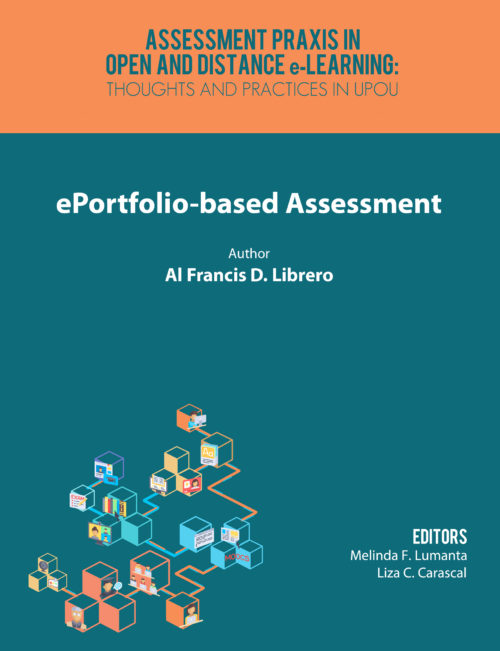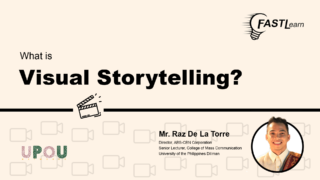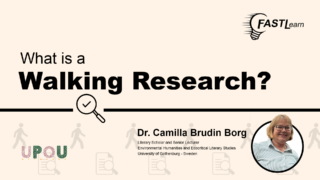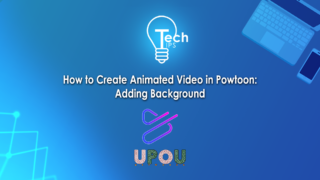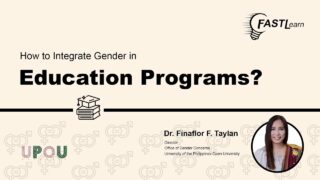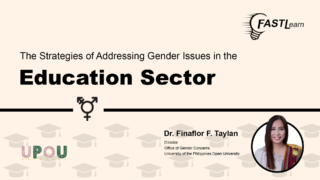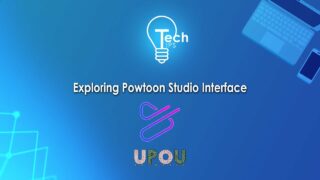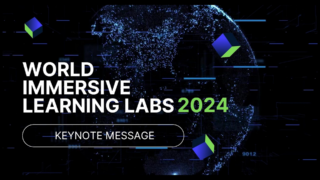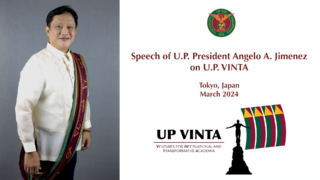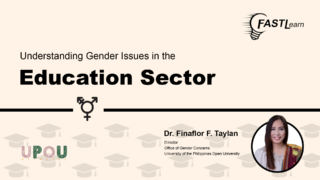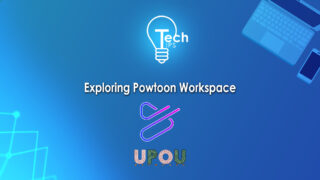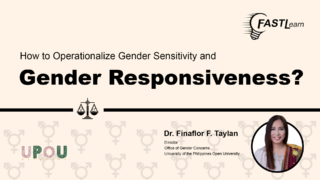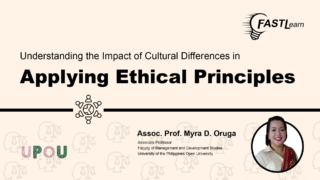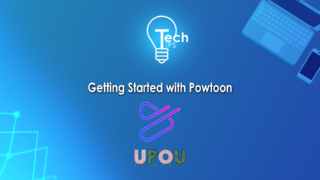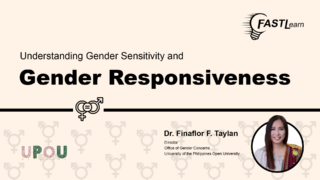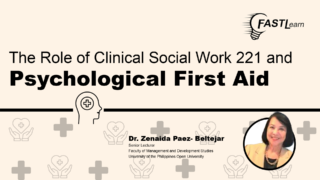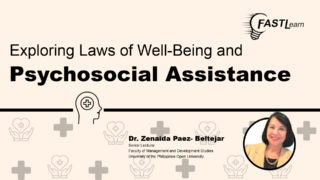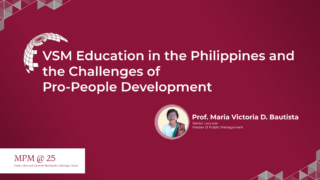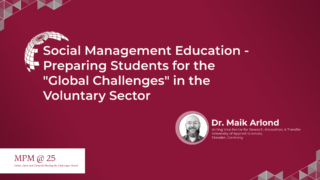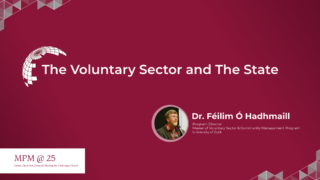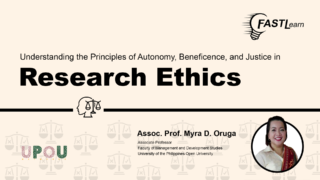This chapter is based on a round table discussion that recounted my experiences in managing an ePortfolio system for UP Open University Bachelor of Arts in Multimedia Studies program from 2014-2017. My direct experience with ePortfolios started much earlier, but it was only in 2014 when I began to sustain a system that continues to this day and spans multiple courses. The primary focus of this discussion is the prospect of what ePortfolios can be as a learning tool, how well students have responded to the system, and how the system has given me a clearer and wider perspective of assessment. I have achieved a fair amount of success, but the university is nowhere near being able to take advantage of all possible opportunities. There is still a long way to go, but I hope we can take that road and get far.
A few of us from the Faculty of Information and Communication Studies (FICS) had been exploring the use of ePortfolio systems much earlier within a few BA Multimedia Studies (BAMS) courses, but program-wide adoption was not attempted until the start of the Academic Year 2014-2015. My personal interest in this has always been about the system itself and the things that can be possible as far as creativity, design, and media is concerned, and as well as getting to know the students who otherwise would have very little idea about. Assessment has always been a second priority for me, but I will share as much as I can to the extent of our experiences when it comes to assessment.
For the past three years, our ePortfolio system has primarily been used as an artifact repository. In this context, artifact refers to evidence of learning or skills like term papers, a glimpse of what their projects are in their respective courses, or maybe notes on activities they do outside the University. A lot of these students are talented; maybe they’re musicians, photographers, or graphic artists. For these students, the ePortfolio system is not only for academic use, but also for sharing their passion be it through photos, videos, or blogs. Previously, we allowed students to use nearly any blogging platform they wanted, because what Modular Object-Oriented Dynamic Learning Environment (MOODLE) provides has limitations which do not make it an ideal management system. We wanted to address that through the ePortfolio system.
Some universities overseas are more advanced with regard to the adoption of ePortfolio systems. In these institutions, an ePortfolio system can typically be an integral part of a learning management system (LMS). MOODLE, for example, works particularly well in tandem with Mahara, an open source ePortfolio system. Unfortunately, while UP Open University can follow suit, we still lack the capacities to do so.
Figure 1 shows the log-in page of the Mahara installation of Athabasca University. The page enumerates the installation’s purposes, which are to showcase academic achievements, professional development, readiness for university work, ideas for course development and revision, and research progress. I have seen only a few of ePortfolios from other universities, but they all share similar objectives which revolve around being a repository of evidence of learning and a showcase for peers, teachers, and institutions.
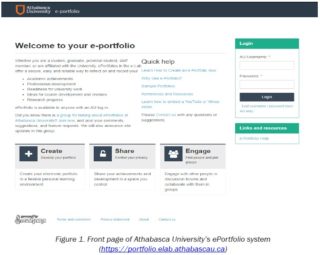
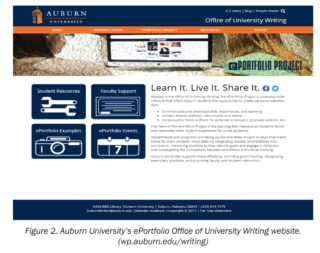
The goals of FICS for operating an ePortfolio system are quite similar. Within those goals are a lot of possibilities and opportunities. The Faculty has made a bit of progress, but it has a long way to go.
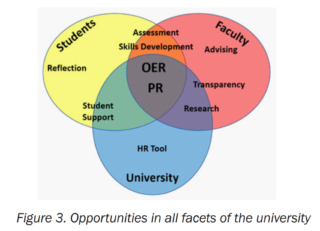
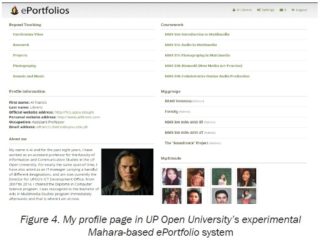
I conducted a preliminary student survey (Librero, 2016) which had 75 respondents who used our Mahara-based ePortfolios system. The respondents, and presumably, the survey, were made up of students from BAMS, the Bachelor of Educational Studies (BES), and the Associate in Arts (AA) programs. Nearly three-fourths of the respondents used the system for at least two courses – enough for them to make informed opinions. They pointed out a number of benefits from the system:
- displays both aptitude and practical skills
- promotes practice of writing in different styles
- engages students more effectively than quizzes and examinations
- allows improved guidance by providing a better glimpse of the students’ profiles.
However, disadvantages from the system were also cited:
- requires additional skill/s
- limits creativity due to system restrictions
- has technical issues
- requires maintenance and provision of support for additional content management system
Weighing the benefits and challenges, almost 95% of the respondents bought into the system, acknowledging the net benefit it allows. They just need more guidance in order to address the cited disadvantages.
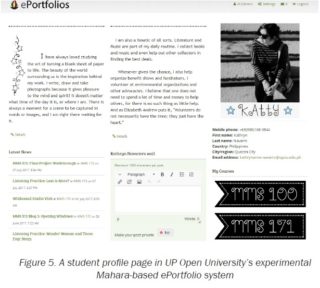
Based on my experience from running the system for three years, the ePortfolio has proven to be an effective platform for self-reflection, allowing deeper perspective on what and how much a student has learned. In my courses, blogging has always been a significant part of assessment as it is one of the major student requirements. Being able to track students directly over multiple courses, I can see how students improve their writing over time. For instance, in MMS 100 (Introduction to Multimedia), students really did not know what they were doing, but by the time they were taking MMS 173 (Photography in Multimedia), a higher course, some of them exhibited a more polished style of writing or, at least, could draw more from their experiences. They became better at expressing themselves or articulating their thoughts.
More importantly, the ePortfolio system is an effective platform for learning by doing, at least as it’s framed in Kolb’s Cycle of Experiential Learning (See Figure 6) (Gibbs, 1988). For example, when I require a final project, it is not enough that I see, hear, or read the project. For MMS 173, I quickly moved away from final examinations to final projects backed up by documentation through their ePortfolios. Anybody can make a project up. Given the learning environment, it would be easy to take certain liberties and a teacher would have a difficult time understanding the students. A documentation comprised of a series of blog entries and a detailed walkthrough of a student’s production process provides a much clearer indication of not just the project results, but also the overall competency throughout the process. As a student articulates these steps in the ePortfolio, I get a clearer picture of each student’s learning experience regardless of how the projects turns out.
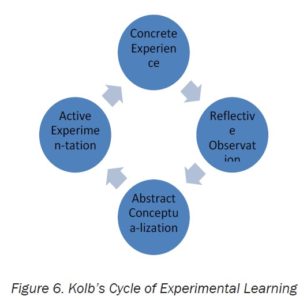
Though it would be easy to believe that having artifacts in the open could facilitate cheating and plagiarism, there are times when it is actually the opposite. I have had a few cases in which students themselves brought to my attention possible similarities of their work to that of their peers, and assured me that cheating was not at play. I do not have the expertise to give a conclusive explanation, but perhaps harboring the very belief that it is too easy to cheat heightens students’ need to be more vigilant in protecting their work.
An area which I recognize but have yet to fully explore is the use of ePortfolios as a tool for academic advising. It first came to mind when I noticed that the students started using the ePortfolio to reflect not just on their studies, but also on other matters that affect their performance – from personal backgrounds, interests, priorities, real-life difficulties to grand aspirations. An ePortfolio has the potential to become a complete package from which a student can be evaluated and advised as to how they should proceed with their studies and what to focus on with their capstone. Ambrose and Ambrose (2013) conducted a study along this line, albeit in a blended environment. The study recognized the importance of taking advantage of technologies such as an ePortfolio system in adopting a different paradigm for advising. The prevailing transactional method of students emailing advisers, who in turn replies accordingly could be replaced by a transformational method, wherein students come in prepared and pre-engaged by advisers through their ePortfolios. The entire process could potentially be more comprehensive and efficient, and through a broad assessment and discussion of an ePortfolio’s content, students can receive deeper, more meaningful advising.
Unfortunately, there are also matters that are yet to be solved within the ePortfolio system. Peer evaluation, and whether or not it can be useful in the learning process, is yet to be studied because there are not much data to work with. It is apparent that students, in general, have not had much practice in peer evaluation for it to be part of their culture. An effective means of encouraging the practice must be discovered and adopted.
Program-wide self-reflection is another issue. The idea is that after students are done with all their coursework, they could go back to look at everything they have loaded on the ePortfolios and then reflect on them, or at least review them on their way to their capstone. There has been little success in carrying this out.
Even with ePortfolios, there is a linearity in learning and assessment that is predominant in UP Open University, or at least in the BAMS program. A student would submit a requirement which will be graded accordingly by the teacher. However, aside from the occasional chance for a student to act on any feedback given, this would be the end of it. This often leads to students not investing themselves in their ePortfolios. I have come across cases where students will abandon their work for years and get back to it only when another course requires its use.
Creative and technical skills are limiting factors when it comes to building ePortfolios. The problem is that BAMS (and possibly any other UP Open University program) does not sufficiently cover all the skills that are relevant, as it is not formally part of any curriculum. The students have to learn and consolidate these skills on their own. As of the moment, I am able to use ePortfolio building as an application of the lessons in MMS 100 (Introduction to Multimedia). However, this action may not be enough as it may be beneficial to BAMS students only. Those from the other programs may be at an even greater disadvantage when they find themselves having to use the ePortfolio system as part of their course requirements.
The FICS has been using a Mahara-based system, which can be strict when it comes to publishing and laying out content. On one hand, it may seem flexible for users with limited experience; on the other, some students with more experience in Web design may find the system too restrictive and can get in the way of their creativity. That is why other than keeping updated with the evolution of Mahara, it will also be prudent to explore other platforms which could serve as an ePortfolio system. For example, I have already begun looking into the new Google Sites to take Mahara’s place. Its feature set at the time of this writing pales in comparison with Mahara; however, the relative ease of generating good-looking and responsive Web pages is particularly appealing. It also entails less administrative responsibilities, making for easier maintenance, as long as Google’s G Suite for Education remains available to users.
First-hand experience has clearly dictated that putting a system in place while offering little to no guidance does not work. Students and teachers alike must understand and appreciate what ePortfolios can offer in comparison to the currently prevailing methods of teaching in UP Open University. A comprehensive guide, such as what the Sweetland Center for Writing in the University of Michigan (https://goo.gl/SKvpqD) offers would be a good start.
Furthermore, ePortfolios must be a formal part of the university’s LMS, having the requisite support staff. This can help assure continued operation, as well as assistance to users in the form of technical support and training.
Institutionalization of the ePorfolio system and the subsequent incorporation of ePortfolio-based assessment in the curriculum, if adopted more aggressively, are actually only the first few steps in the grand scheme of things. Teachers themselves will have to learn how to design and build ePortfolios for themselves and their students; this entails a lot of discussion and hands-on training. With that said, I do believe that the underlying issue to be solved is not technical in nature.
We will have to be open to modifying our teaching methods. Otherwise, my fear is that we will have the tendency to revert back to older tools, as they are the ones which we are more accustomed to, and therefore, can employ with relative ease and convenience. Nguyen (2013) put forward the idea of an ePortfolio system’s capacity to support a different paradigm and act as a living portal. An ePortfolio can continually be interpreted and reinterpreted by students and viewers, including teachers. It implies the end result of richer ePortfolio content. This, in turn, would allow teachers a wider and clearer picture as far as assessment and academic advising is concerned. This is something that we, as a university, must want to embrace.
What I see as the most important task in a long term goal (not just adoption, but includes sustained use) is the development of a legitimate ePortfolio culture. Teachers must lead by example in maintaining their own ePortfolios and regularly writing at least short blogs. Students must openly share comments and suggestions amongst each other, as they would in social networking sites. While institutionalization in UP Open University would not mean mandatory use across all programs, everyone must accept the idea that ePortfolio development should be embraced as much as we did the LMS, social media and all the other online applications we use for our day-to-day operations.
I rediscovered something that I overlooked a few years ago when I started looking into ePortfolios – the concept of ePorticulture (Shada, Kelly, Cox, and Malik, 2011); the act or custom of learning; intellectually and professionally developing; transmitting knowledge through the creation; and reviewing and assessing authentic, reflective, and integrative student work shared over time in electronic portfolios. The concept is the combination of ePortfolio-building, agriculture, and horticulture. There are four steps in cultivating crops which can be analogous to ePortfolio development. First is preparing the soil, where you get stakeholders to buy into the system. Second is planting seeds or transplanting plants which is analogous to the formal institutional adoption and valuation of the system. Third is growing and maintaining plants as building skills and motivation, and keeping the system up and running. The final stage in the cycle is harvesting where actual ePortfolio pages and artifacts are created and shared through the system.
Essentially, the trick is to get people to buy into the whole thing. If you are a teacher, the first factor you’d think of might be the students’ attitude towards the system. However, in my experience, adoption on their part is not much of a problem. Ironically, the issue is at the institutional and Faculty levels. This is not about convincing people that using ePortfolio for assessment is a good idea. This is about the university, or more specifically, the Faculty actually adopting the system, making them believe that it is to their best interest to get into it, and then actually use the system. Learn by doing, then lead by example — that happens to be another key. I wouldn’t be confident about ePortfolio-based assessment had I not gotten into constructing it myself. The challenge is worth the effort. I hope that, in time, more people will not just feel the same, but invest their time and effort to embrace it as well.
Gibbs, G. (1988). Learning by doing: a guide to teaching and learning methods. Further Education Unit. Oxford Polytechnic: Oxford, UK.
Librero, A.F.D. (2016). Early experiences with ePortfolio-based learning in an open distance eLearning environment in the Philippines. Paper presented at SAI 2016 STEM-ATEM-ICEM Joint International Conference, Seoul, South Korea.
Nguyen, C.F. (2013). The ePortfolio as a living porta: a medium for student learning, identity, and assessment. International Jounral of ePortfolio. 3:2. 135-148.
Shada, A., Kelly, K. Cox, R. and Malik. S. (2011). Growing a new culture of assessment: planting ePortfolios in the metro academies program. International Journal of ePortfolio, 1(1.) 71-83.
Teaching with ePortfolios. (n.d.). Retrieved from https://lsa.umich.edu/sweetland/instructors/teaching-resources/teaching-with-eportfolios.html.
Welcome to your e-portfolio. (n.d). Retrieved from https://portfolio.elab.athabascau.ca
What is an ePortfolio. (n.d.) Retrieved from https://www.elearning.uq.edu.au/content/what-eportfolio
Librero, A. D. (2018). ePortfolio-based Assessment. In M. F. Lumanta, & L. C. Carascal (Eds.), Assessment Praxis in Open and Distance e-Learning: Thoughts and Practices in UPOU (pp. 51-64). Los Baños, Laguna, Philippines: UP Open University
